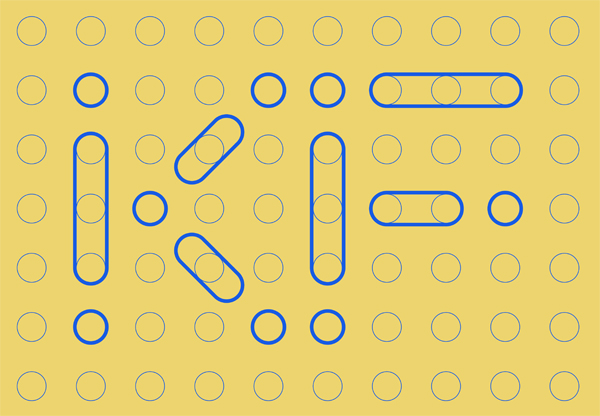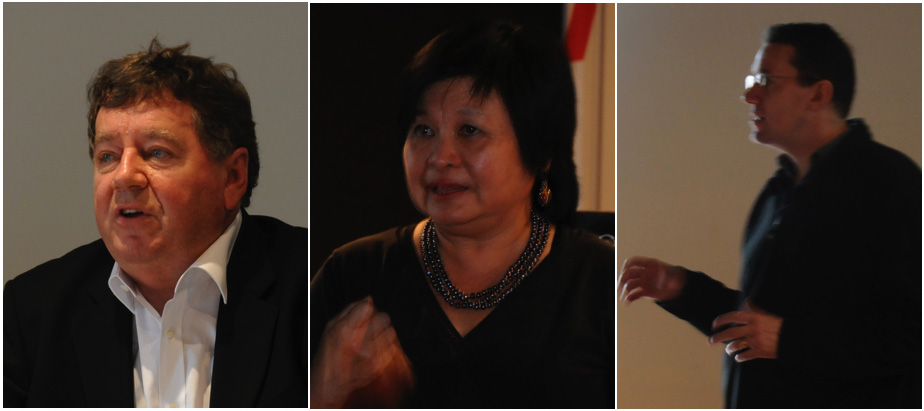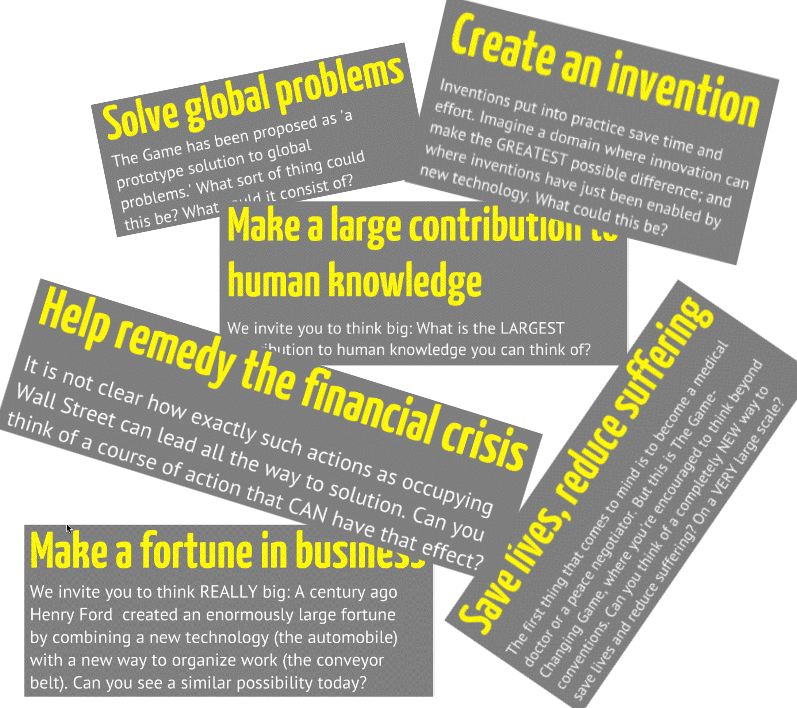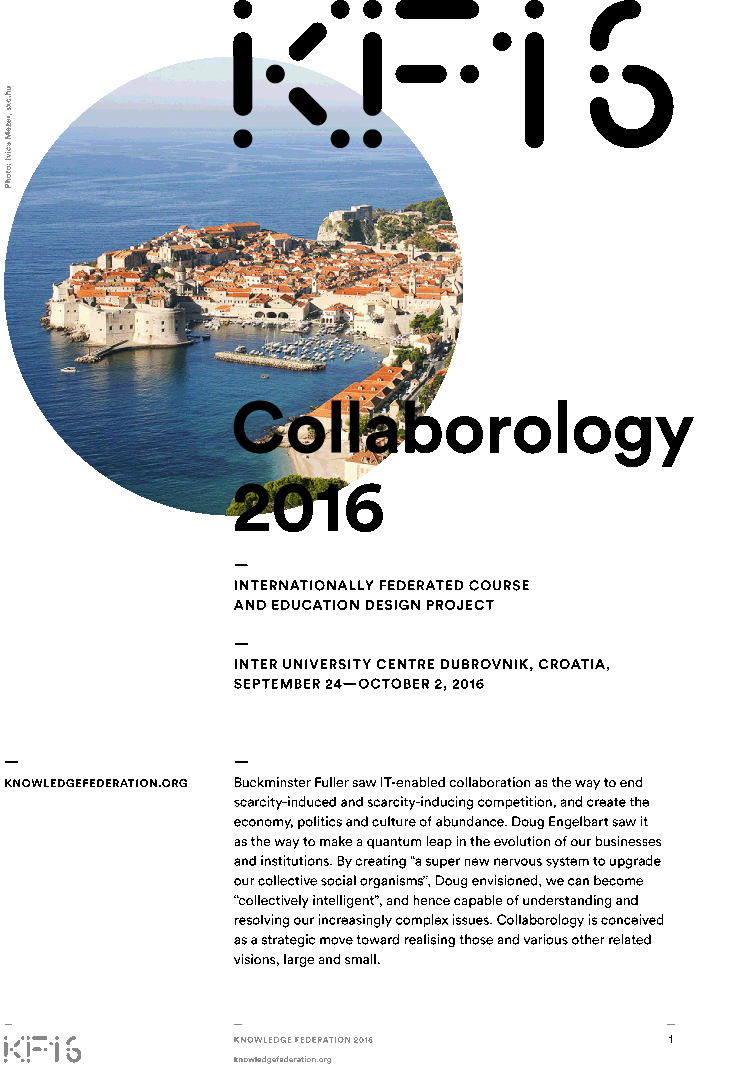SECOND-APPLICATIONS
Contents
Federation through Prototypes
(Alexander Laszlo, motto and call to action at the International Society for the Systems Sciences yearly conference in Haiphong, 2013)
"The tie between information and action has been severed", Neil Postman warned in his 1990 keynote Informing Ourselves to Death.
Which is the mother of all our problems; which the Modernity ideogram points to.
"Objective observers" will not resolve this problem; the action with which the change of our evolutionary course must begin is self-organization; by which we become new systems—capable of turning information into action.
Prototypes restore the severed tie between information and action.
They are the characteristics products of creative work in the emerging paradigm; as academic books and articles are in the present one.
A prototype is
- a model, functioning in reality, exhibiting a collection of challenge–solution pairs, or design patterns as we are calling them; and showing how to combine those design patterns in a coherently functioning whole
- an intervention, strategically designed to alter certain conventional practice or system
- an experiment, showing what in the proposed design works well, and what needs to be improved.
A prototype is not complete unless it has a clear and realistic impact model and a deployment plan.
In knowledge
The knowledge federation prototype is conceived as society's evolutionary organ.
Which enables not only the culturally-relevant insight and experiences (which emerged in academic fields and other cultural traditions) to be connected as dots into higher-order units of meaning—but also people and technology to be united into entirely different systems; endowed with creativity, intelligence and vision.

The knowledge federation prototype enables knowledge-based systemic change.
A prototype of a system is created, and a transdiscipline around it—to update it and give it real-life impact; according to the state-of-the-art disciplinary and other insights that everyone brings along. Knowledge federation creates the transdiscipline by creating itself.
We use this keyword, knowledge federation, in a similar way as "design" and "architecture" are used—to denote both a certain praxis (informed practice) and the academic field that develops it.
The knowledge federation points to the challenge and opportunity that we as generation must respond to by urgent action—to liberate our next generation from "the world" that has been pulled over their eyes; to empower our students and children to be creative in ways and in degrees their situation necessitates.
It is no longer necessary to to write articles in traditional sciences to be acknowledged and sponsored as scientist.
Knowledge federation is a prototype of the transdiscipline.
And a model of a vast creative frontier. Having found ourselves in a realm of creative opportunities and challenges immensely larger than what we ourselves could develop, we worked in the manner of prospectors—and endeavored to chart it and structure it by creating prototypes; and in that way enable and streamline large-scale development.
The knowledge federation prototype has been conceived in terms of about forty smaller prototypes; which model new ways to implement all those various parts and functions that constitute a discipline—ranging from epistemology and methodology to a community of state-of-the-art experts and examples of application. Together those prototypes compose a coherent whole—a prototype of a functioning transdiscipline.
In information
How can I do justice to the Innovation Ecosystem for Good Journalism prototype we created in Barcelona in just a few lines? I’ll just highlight a couple of (design questions that define) its design patterns:
- What should information (that empowers the post-industrial democracy to see and follow a viable course) be like; and who and how will create it?
- How should public informing as a system be structured; and who and how will create it?
Information must turn perceived problems into systemic action.
How else will democracy ever be able to transform candles into lightbulbs?
The system of public informing we envisioned as two loops forming the number 8; where the lower loop identifies and curates problems (we empowered the people to do this directly; by building on Barcelona's WikiDiario citizen journalism project); and where the upper loop identifies (by engaging academic and other experts) and communicates (through the agency of knowledge federation's communication design team) their systemic solutions. How else shall we ever know, I explained in the Liberation book, that "corporate personhood" for instance could be an issue?
Our Barcelona prototype prototyped also a system by which journalism could be created and perpetually re-created.

We were fortunate to have with us Paddy Coulter (director of Oxford Global Media and former director of Oxford University Reuters School of Journalism); who had also been a keynoter at our formative 2010 workshop in Dubrovnik. In the manner of giving the good journalism tradition the reigns, we asked Paddy to chair the Barcelona event.
We techies should not allow ourselves to reinvent journalism.
Our task was to facilitate its evolution—by federating transformative memes. In Barcelona workshop Mei Lin Fung (founder of the Silicon Valley-based initiative to continue and complete Doug Engelbart's vision called Program for the Future) represented the Doug Engelbart legacy; David Price (co-founder of Debategraph as the leading collective mind initiative, and of Global Sensemaking as the global community of collective mind researchers and developers) led the technology team.
In empowerment
As an experiment, the prototype we crafted in Barcelona gave us an invaluable insight: When the journalists who co-created it with us returned to their busy editorial desks—they were out of sight! This helped us realize that the people who have power positions within a system will not be the one who can change that system; they are too busy running it!

A system that can change systems must be conceived differently!
And so the following year, at our 2012 Palo Alto workshop, we crafted a prototype of a system called the game-changing game; and presented it at the Bay Area Future Salon.
The game-changing game is not a game in ordinary sense, but a game-changing way to have a career; where instead of playing by the rules, instead of trying to fit in an existing profession or system—the players undertake to change a system. The game-changing game has two categories of players: The A-players (who as graduate students, or entrepreneurs in search of a project) are in a career and life phase where change is natural and easy; and the Z-players (who as professors, or investors) are in positions of power.
The Z-players play the game-changing game by empowering the A-players to pursue their career goals by changing a system.
In 2012 in Zagreb we created the club of Zagreb—a redesign of The Club of Rome based on the game-changing game.
In education
A natural way to change course is by changing education.
Which recreates the world with every new generation; unless, of course, it's conceived as a way to pull "the world" over their eyes; and press them into the mold of our already obsolete systems and professions.
The collaborology prototype models the education we now need.
And organizes us in creating or federating such education.

Here too I'll only mention two of its design patterns.
In the collaborology prototype education is by pull, not push.
Which translates into a whole spectrum of advantages—by developing creativity, and collaboration ethics and skills, and other personality traits that are so much in need; and by enabling education to be life-long and need or interest-based
The collaborology course is internationally federated.
By enabling—through suitable use of new technology—everyone in the world to participate in the course as (both!) students and instructors. Which translates into another spectrum of advantages—including that it enables (provides a sustainable business model for) the creation of a (new) transdiscipline; and engenders the economies of scale that are characteristic of systemic innovation (instead of teaching the whole course, each instructor is responsible only for a single module).

